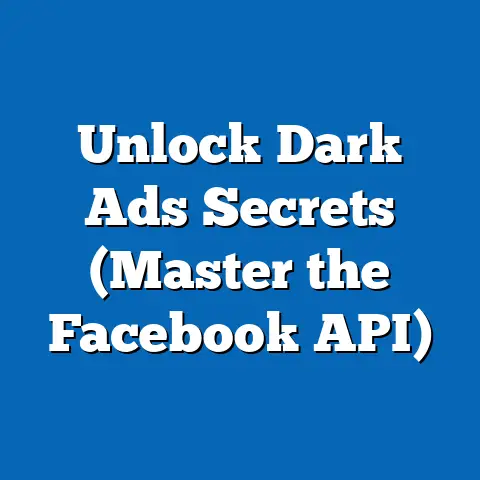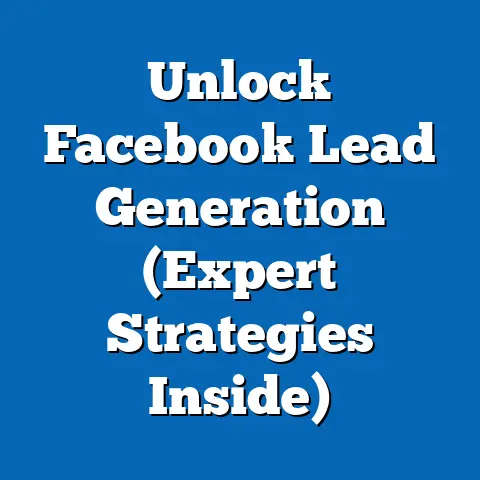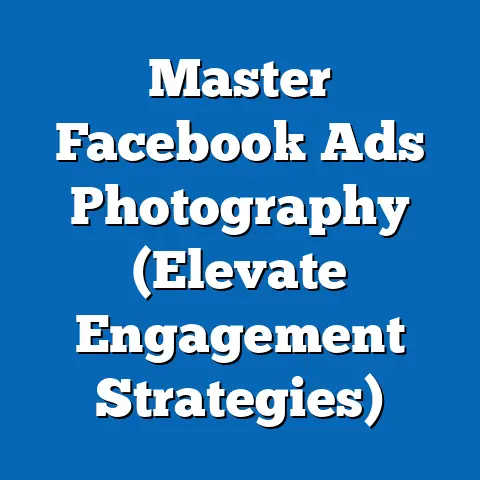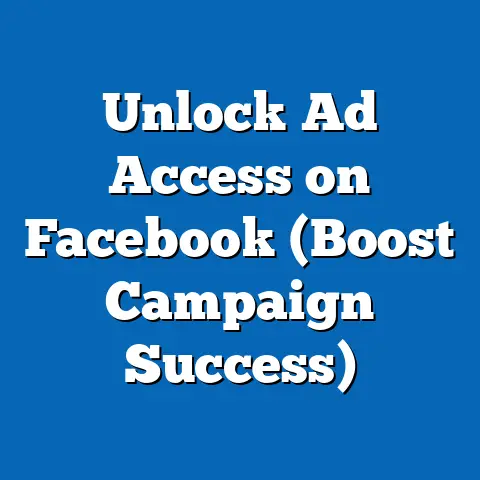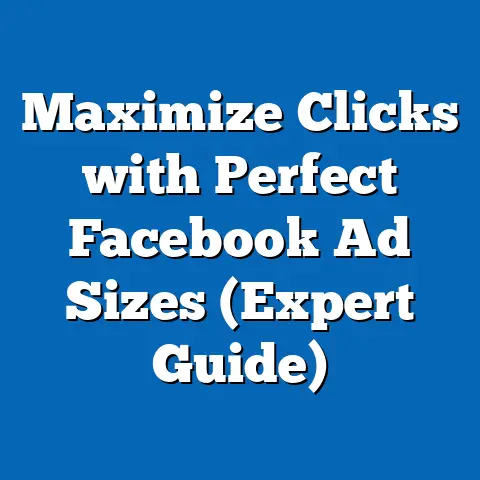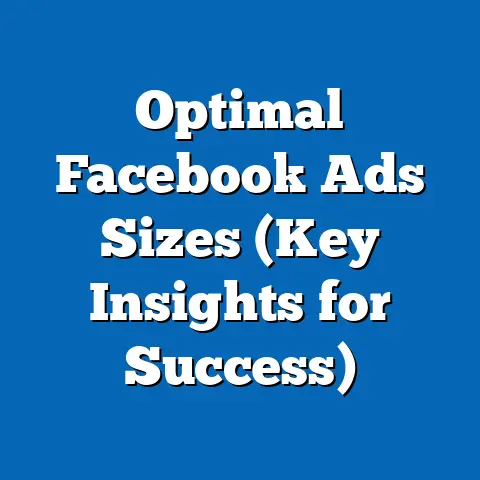Mastering Facebook Single Image Ads (Essential Specs Revealed)
Why did the marketer break up with the calendar? Because it had too many dates! (I always love starting with a little humor, especially when diving into a topic that can sometimes feel a bit… technical). But trust me, mastering Facebook single image ads doesn’t have to be a chore. In fact, it can be a powerful way to capture attention and drive serious conversions.
In today’s digital marketing landscape, Facebook single image ads are your reliable workhorse. They’re simple, direct, and, when done right, incredibly effective. Think of them as the perfectly framed snapshot that stops someone mid-scroll. But the secret sauce? It’s not just about pretty pictures. It’s about understanding the essential specifications that Facebook demands.
This guide is your deep dive into the world of Facebook single image ads. I’m going to walk you through everything you need to know, from the technical specs (image size, file formats, the dreaded text-to-image ratio) to design best practices and audience targeting strategies. We’ll even cover analyzing performance and making adjustments so you can continuously optimize your campaigns. Let’s get started!
Understanding Facebook Single Image Ads
So, what exactly are single image ads? Simply put, they are advertisements on Facebook that feature a single static image. Unlike carousel ads that showcase multiple images or video ads that use moving visuals, single image ads rely on the power of one compelling image to convey your message.
I remember when I first started running Facebook ads, I was immediately drawn to the flashier options – videos, carousels, even the now-defunct Canvas ads. But I quickly realized that single image ads held their own, and in some cases, even outperformed the more complex formats.
Advantages of Single Image Ads
Here’s why I think single image ads are still a vital part of any Facebook advertising strategy:
- Simplicity: They’re easy to create and manage. You don’t need fancy video editing skills or multiple product shots.
- Clarity: A single, well-chosen image can communicate your message instantly. There’s no room for confusion.
- Ease of Design: You can create eye-catching visuals with basic design tools or even using templates within Facebook Ads Manager.
- Cost-Effective: Often, single image ads are more budget-friendly to produce than video or carousel ads.
- Mobile-Friendly: They display well on mobile devices, which is crucial considering the majority of Facebook users access the platform on their phones.
When Are Single Image Ads Most Effective?
While versatile, single image ads shine in specific scenarios:
- Brand Awareness Campaigns: A striking image with your logo can effectively build brand recognition.
- Product Promotions: Showcase a single, hero product with a clear call to action.
- Seasonal Sales: Highlight limited-time offers with visually appealing graphics.
- Event Announcements: Announce upcoming events with an eye-catching image that captures the event’s essence.
- Driving Traffic to a Specific Landing Page: A clean, focused ad can effectively drive traffic to a specific page on your website.
Takeaway: Single image ads are a powerful and versatile tool in your Facebook advertising arsenal. Their simplicity and clarity make them ideal for a variety of campaigns.
Essential Specifications for Facebook Single Image Ads
Now, let’s get down to the nitty-gritty: the technical specifications. I know, this isn’t the most exciting part, but trust me, getting these right is crucial. Facebook is notoriously picky, and if your ad doesn’t meet their requirements, it simply won’t run. I’ve learned this the hard way with rejected ads and wasted budgets.
Here’s a detailed breakdown:
Image Size and Dimensions
- Recommended Dimensions: 1080 x 1080 pixels (for square images). This is the sweet spot for most placements.
- Minimum Dimensions: 600 x 600 pixels. While you can go smaller, I strongly advise against it. The image will likely appear pixelated and unprofessional.
- Aspect Ratio: 1:1 (square), 1.91:1 (landscape), and 4:5 (vertical) are generally accepted. However, 1:1 and 4:5 tend to perform best on mobile.
Why This Matters: Using the correct dimensions ensures your image looks crisp and clear on all devices. It prevents cropping issues and avoids that dreaded “low-quality image” warning from Facebook.
File Formats
- Supported Formats: JPEG and PNG are your best bets.
- Recommendation: I generally prefer JPEG for photos and PNG for graphics with text or logos. PNG tends to handle text and sharp lines better, preventing blurriness.
Why This Matters: Using the correct file format ensures compatibility and optimal image quality.
File Size
- Maximum File Size: Facebook typically recommends keeping your image file size under 125MB.
Why This Matters: Smaller file sizes load faster, improving the user experience and potentially boosting your ad’s performance. Large files can slow down load times, leading to people scrolling past your ad.
Text Guidelines: The 20% Rule (Sort Of)
Ah, the infamous 20% text rule. This used to be a strict policy where Facebook would reject ads with more than 20% of the image covered in text. Thankfully, they’ve relaxed this rule, but text placement and density still matter.
- Current Policy: Facebook now prefers images with little to no text. Ads with excessive text may reach a smaller audience.
Why This Matters: Facebook prioritizes user experience. They believe that ads with too much text are disruptive and less engaging.
My Tips for Text:
- Keep it concise: Use as little text as possible. Focus on a strong headline and a clear call to action.
- Use the ad copy: The text in your ad copy is just as important as the text in your image. Use it to elaborate on your message.
- Test different versions: Use Facebook’s A/B testing feature to see how different text-to-image ratios affect your ad performance.
- Use the Text Overlay Tool: Facebook still provides a Text Overlay Tool that can help you estimate the amount of text in your image. While it’s not a strict requirement, it’s a useful guide.
Call-to-Action (CTA) Buttons
- Available CTAs: “Learn More,” “Shop Now,” “Sign Up,” “Download,” “Contact Us,” “Book Now,” and more.
- Importance: A clear CTA tells users what you want them to do. It’s the bridge between seeing your ad and taking action.
Why This Matters: A well-chosen CTA can significantly improve your conversion rates. It guides users towards the desired outcome.
My Tip: Choose a CTA that aligns with your campaign objective. If you’re promoting a product, “Shop Now” is a natural choice. If you’re trying to generate leads, “Sign Up” or “Learn More” might be more effective.
Takeaway: Adhering to Facebook’s technical specifications is essential for getting your ads approved and ensuring they display correctly. Pay close attention to image size, file formats, text guidelines, and CTA options.
Designing Effective Single Image Ads
Okay, now for the fun part: designing ads that actually grab attention and convert! I’ve seen countless ads that technically meet all the specifications but still fall flat. It’s not enough to just have a pretty picture. You need a visually compelling design that resonates with your target audience and drives them to take action.
Here are my top tips for creating effective single image ads:
Choosing the Right Image
- High-Quality Visuals: This is non-negotiable. Use high-resolution images that are clear, sharp, and well-lit. Avoid blurry or pixelated images at all costs.
- Relevance: Choose images that are relevant to your product, service, or offer.
- Authenticity: Stock photos can work, but try to use images that feel genuine and relatable. User-generated content (UGC) can be particularly effective.
- Emotion: Images that evoke emotion (joy, excitement, curiosity, etc.) tend to perform better.
- Testing: Don’t be afraid to test different images to see what resonates best with your audience.
My Experience: I once ran a campaign for a local coffee shop. Initially, I used a generic stock photo of a latte. The results were… underwhelming. Then, I switched to a photo of a real customer enjoying a coffee in the shop. The engagement skyrocketed! People responded much better to the authentic image.
Branding Elements
- Subtlety: Incorporate your logo and brand colors, but don’t overwhelm the ad. A small, tasteful logo is usually sufficient.
- Consistency: Maintain consistent branding across all your ads. This helps build brand recognition.
- Placement: Experiment with different logo placements to see what works best.
Why This Matters: Branding helps users recognize your ads and associate them with your brand.
Color Schemes and Typography
- Color Psychology: Consider the emotional associations of different colors. For example, blue often conveys trust and reliability, while red conveys excitement and energy.
- Contrast: Use colors that contrast well with each other to make your ad stand out.
- Readability: Choose fonts that are easy to read, even on small screens. Avoid overly decorative or script fonts.
- Font Hierarchy: Use different font sizes and weights to create a visual hierarchy. The most important text (e.g., your headline) should be the most prominent.
My Tip: I often use Adobe Color to create color palettes that are visually appealing and consistent with my brand.
Ad Copy Best Practices
- Conciseness: Keep your ad copy short and to the point. People have short attention spans.
- Clarity: Clearly communicate your message. What are you offering? What do you want users to do?
- Benefit-Driven: Focus on the benefits of your product or service, not just the features.
- Urgency: Create a sense of urgency to encourage immediate action (e.g., “Limited-time offer,” “Sale ends soon”).
- Call to Action: Include a clear call to action in your ad copy that complements the CTA button.
Example:
- Bad: “Our new widget is the best widget ever!”
- Good: “Get 20% off our new widget and boost your productivity today! Shop Now.”
Takeaway: Effective single image ads are a blend of compelling visuals, clear messaging, and strategic branding. Pay attention to image quality, color schemes, typography, and ad copy to create ads that grab attention and drive conversions.
Targeting Your Audience
You could have the most beautiful, perfectly designed ad in the world, but if you’re showing it to the wrong people, it’s going to be a waste of money. That’s why audience targeting is so crucial. It’s about defining and reaching the ideal audience for your single image ads.
Facebook offers a wealth of targeting options, allowing you to narrow down your audience based on:
- Demographics: Age, gender, location, education, job title, etc.
- Interests: Hobbies, activities, pages they like, etc.
- Behaviors: Purchase history, online activity, device usage, etc.
- Connections: People who like your page, their friends, etc.
But the real magic happens when you start creating custom and lookalike audiences:
- Custom Audiences: These are audiences you create based on your own data, such as email lists, website visitors, or app users.
- Lookalike Audiences: These are audiences that Facebook creates based on the characteristics of your existing customers or website visitors. They’re essentially people who are similar to your best customers.
My Strategy: I always start with broad targeting and then gradually narrow it down based on performance data. I also experiment with different custom and lookalike audiences to see which ones are most responsive.
Takeaway: Audience targeting is essential for maximizing the effectiveness of your single image ads. Use Facebook’s targeting options to reach the right people and improve your conversion rates.
Analyzing Performance and Making Adjustments
Finally, it’s time to track your results and make adjustments. Facebook Ads Manager provides a wealth of data that you can use to analyze your ad performance.
Here are some key metrics to track:
- Impressions: The number of times your ad was shown.
- Reach: The number of unique people who saw your ad.
- Click-Through Rate (CTR): The percentage of people who saw your ad and clicked on it.
- Engagement Rate: The percentage of people who interacted with your ad (likes, comments, shares).
- Conversion Rate: The percentage of people who completed a desired action (e.g., purchased a product, signed up for a newsletter).
- Cost Per Click (CPC): The average cost you paid for each click on your ad.
- Cost Per Conversion (CPC): The average cost you paid for each conversion.
- Return on Ad Spend (ROAS): The amount of revenue you generated for every dollar you spent on advertising.
A/B Testing:
A/B testing (also known as split testing) is the process of testing different variations of your ads to see which ones perform best. You can test different images, ad copy, CTAs, and targeting options.
My Process:
- Identify areas for improvement: Look at your performance data and identify areas where your ads are underperforming.
- Create variations: Create different versions of your ads with variations in the elements you want to test.
- Run the test: Run your A/B test for a sufficient amount of time to gather statistically significant data.
- Analyze the results: Analyze the results of your test and identify the winning variation.
- Implement the changes: Implement the changes based on your test results and continue to monitor your ad performance.
Takeaway: Analyzing your ad performance and making adjustments is an ongoing process. Use Facebook Ads Manager to track key metrics, run A/B tests, and continuously optimize your campaigns for better results.
Conclusion
Mastering Facebook single image ads is a journey, not a destination. It’s about understanding the platform’s specifications, crafting compelling visuals, targeting the right audience, and continuously analyzing and optimizing your campaigns.
Remember to experiment with your ad designs, test different approaches, and always keep the essential specs in mind. By doing so, you can unlock the power of Facebook single image ads and drive significant results for your business.
Now, I’d love to hear from you! What are your experiences with Facebook single image ads? What tips and strategies have worked best for you? Share your thoughts in the comments below, or reach out if you have any questions. Happy advertising!

